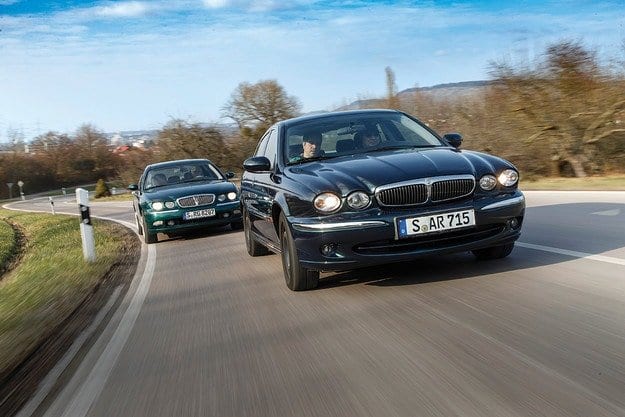
Test drive Jaguar X-Type 2.5 V6 and Rover 75 2.0 V6: British middle class

If you're dreaming of a classic British model, now is the time for a bargain.
About 20 years ago, the Jaguar X-Type and Rover 75 tried to break into the middle class, relying on British broadcasting. Today these are cheap used cars for private individuals.
Didn't the Rover 75 get too much retro styling? This question is inevitably asked when observing the chrome-framed oval main controls with their bright, almost patinated dials. To their right, on the imitation wood dashboard, is a small clock that looks like it, which, unfortunately, does not have a second hand. Its constant ticking radiates an even more nostalgic mood.
A beautifully shaped steering wheel with airbags and a thick leather ring, black plastic levers on the steering column, and black dashboard upholstery take us back to 2000 when the green Rover 75 2.0 V6 Automatic rolled off the assembly line. The comfortably furnished interior of the British mid-range sedan, along with the retro dials of the instruments, is distinguished by another design feature: not only the speedometer and tachometer are oval in shape, but also the ventilation nozzles, chrome door handle recesses and even the door buttons. ...
Rover covered in chrome
On the outside, the Seventy-Five sedan has a rather simple 50s look with its generous chrome trim. The arched door handles integrated into the side trim strips are particularly attractive. As a concession to the taste of the weather in 1998, when Rover unveiled the 75 at the Birmingham Auto Show, the front-wheel-drive model received a relatively tall rear with a sloping rear window. Also modern are the four round headlights, slightly covered by the front cover, which give the meek Briton a rather determined look.
This model is very important for Rover and BMW. After the Bavarians bought the Rover from British Aerospace in 1994, the 75 pioneered a new era alongside MGF and New Mini. The British-styled sedan was designed to compete not only with the Ford Mondeo, Opel Vectra and VW Passat, but also with the Audi A4, BMW 3 Series and Mercedes C-class.
However, two years after its market premiere in 2001, another middle-class competitor appeared - the Jaguar X-Type. What's more, with its British-accented retro look, it spoke almost the same design language as the Rover 75. This gives us enough reason to compare the two nostalgic models with a shared drive and see if behind the handsome façade it fits its time and is enough reliable technology.
Island twins
Seen from the front, the two four-eyed faces of Jaguar and Rover, with nearly identical front grilles, are nearly indistinguishable from each other. The only difference is the distinctive shape of the Jaguar bonnet, with protrusions starting above the four oval headlights. This makes the X-Type even look like a smaller XJ, and the rather rounded rear end, especially in the rear speaker area, resembles the much larger S-Type that debuted two years earlier. Thus, in 2001, Jaguar's lineup consisted of just three retro sedans.
Evaluating a car's design has always been a matter of personal taste. But the slight hip flexion above the rear wheel in the X-Type just went overboard with folds and ridges in a relatively small space. The Rover looks better in profile. It's fair to say here that due to the quiet winter conditions on the roads, the X-Type participates in the photo shoot with black steel wheels instead of the attractive standard seven-spoke aluminum wheels.
The similarities between the two bodies persist in the interior. If it weren't for the simple modern X-Type controls, you might think you are sitting in the same car. For example, the soft edges around the wood-styled dashboard and above all around the center consoles are virtually identical.
Both cabins in their luxurious Executive versions in the X-Type and Celeste in the 75 look even better and, most importantly, more colorful. Cream leather seats with navy blue stitching in a Rover or a wooden steering wheel and various interior colors in a Jaguar make just about every Briton on the used car market a unique example. Of course, comfort equipment leaves almost unfulfilled desires: from air conditioning to electrically adjustable seats with memory function to a sound system that plays CDs and/or cassettes, everything is there. In this situation, a well-equipped Jaguar X-Type or V75-powered Rover 6 was not a cheap car. When it debuted on the market, luxury versions had to pay about 70 marks.
Equipment from the mother of the concern
The X-Type and 75's claims to be elite are backed by Jaguar and Rover with state of the art equipment supplied in part by parent companies Ford and BMW. Jaguar has been part of the Ford Premier Automotive Group (PAG) since 1999. For example, the X-Type has the same chassis as the Ford Mondeo, as well as V6 engines with two overhead camshafts (DOHC) and a displacement of 2,5 (197 hp) and three liters. from.). All X-Type except the base version, with a 234-liter V2,1 (6 hp) and a four-cylinder diesel engine rated at 155 and later, producing 128 hp. get a dual transmission, which explains the meaning of the letter "X" as a symbol of all-wheel drive.
BMW also has BMW know-how in many places. Due to the sophisticated rear axle design borrowed from the "five" and the tunnel integrated into the chassis to drive the rear axle, the 75 was often claimed to have its platform originated in Bavaria. However, it is not. Undoubtedly, however, the two-liter diesel with 116 hp and then 131 hp, which was offered from the beginning, came from Bavaria. Rover petrol engines are 1,8-liter four-cylinder with 120 and 150 hp. (turbo), a two-liter V6 with 150 and a 2,5-liter V6 with 177 hp.
Legendary is the Rover 75 V8 with a 260 hp Ford Mustang engine. Specialist rally car manufacturer Prodrive performs a conversion from front to rear transmission. The V8 engine is also found in Rover's twin MG ZT 260. But two prestigious cars with only 900 built in total could not prevent Rover's decline after BMW's departure in 2000. April 7, 2005 Rover was declared bankrupt, this is the end of the 75th.
Too bad, because the car is solid. Back in 1999, auto motor und sport testified that the 75 had "good workmanship" and "body torsion resistance". In all comfort disciplines - from suspension to heating - there are only advantages, including in the drive, where only "light blows to the engine" are recorded.
Indeed, by today's standards, the Rover rides extremely elegantly and, above all, with a pleasantly soft suspension. The steering and driver's seat could have been more precise and stiff, and the small two-liter V6 with a decidedly larger displacement. At a quiet boulevard pace with a five-speed automatic, there is no sure grip. But if you press the pedal harder against the carpet on the floor, you will be blown up to 6500 rpm at night, out of breath.
In direct comparison, the low-end Jaguar clearly benefits from more displacement and power. Its 2,5-liter V6, even without high revs, responds smoothly but decisively to any command with the accelerator pedal. At the same time, the car is helped by a high-quality five-speed manual gearbox, which, however, does not switch very accurately. In addition, the Jaguar's engine runs a little more erratically than a well-trained V6 Rover. However, driving comfort, seating position, cabin size and relatively high fuel consumption are almost identical - both models do not fall below ten liters per 100 km.
It remains to be seen why a Rover representative, like the one with a model older than ten years, Alfa Romeo, received the number 75. This is another reminder of the good old days: one of the first post-war Rover models is also called the 75.
Conclusion
X-type or 75? For me, this would be a difficult decision. Such is the Jaguar with a three-liter V6 and 234 hp. can be a big advantage. But for my taste, his body is too bloated. In this case, it is better to prefer the Rover model - but as a racial MG ZT 190 without chrome trim.
Text: Frank-Peter Hudek
Photo: Ahim Hartmann
Home " Articles " Blanks » Jaguar X-Type 2.5 V6 and Rover 75 2.0 V6: British middle class

